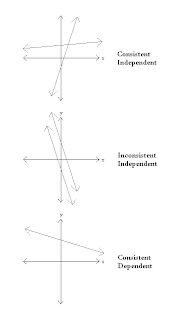- Difference of two squares
- a2- b2 = (a + b)(a - b)
- (x + 9)(x − 9)
- (6x − 1)(6x + 1)
- (x3 − 8)(x3 + 8)
- Trinomial perfect squares
- a2 + 2ab + b2= (a + b)(a + b) or (a + b)2
- a2 - 2ab + b2 = (a - b)(a - b) or (a - b)2
- a2 + 2ab + b2= (a + b)(a + b) or (a + b)2
- Difference of two cubes
- a3 - b3
- 3 - cube root 'em
- 2 - square 'em
- 1 - multiply and change
- 64x^-1
- x^3-216
- a3 - b3
- Sum of two cubes
- a3 + b3
- 3 - cube root 'em
- 2 - square 'em
- 1 - multiply and change
- x^3+27= (x^3)(x^2-3x+9)
- 8x^3+27
- x^3=25
- a3 + b3
- Binomial expansion
- (a + b)3 = a^3+3a^2b+3ab^2+b^3
- (a + b)4 =
Int Alg II - Kennedy Jones
Wednesday, December 1, 2010
Identifying special situations in factoring
End Behaviors/Naming Polynomials
Linear Equations:
Domain - x values
Range - y values referred to as f(x)
y= mx+b
1 degree
0 turns
Domain - x values
Range - y values referred to as f(x)
| When M is Positive: domain → +∞, range → +∞ (rises on the right) domain → -∞, range → -∞ (falls on the left) |
 |
When M is Negative domain → -∞, range → +∞ (rises on the left) domain → +∞, range → -∞ (falls on the right) |
Quadratic Equations (parabolic equation)
y=ax²
2 degree
1 turn
(a+b)(c+d)
when A is positive.
when A is negative.
End Behaviors/Naming Polynomials
Naming Polynomials:
--Number of turns is always 1 less than the degree.
Degree:
0- Constant
1- Linear
2- Quadratic
3- Cubic
4- Quartic
5- Quintic
6 to ∞- nth Degree
Terms:
Monomial
Binomial
Trinomial
Quadrinomial
Polynomial
domain → +∞, range → -∞ (falls on the right)
domain → -∞, range → -∞ (falls on the left)
domain → +∞, range → +∞ (rises on the right)
domain → -∞, range → -∞ (falls on the left)
Wednesday, October 6, 2010
identify quadratic functions
Standardform: ax² + bx + cy² + dy + e= 0
If a=c, then the equation is a circle.If you have an equation like 5x² + 5y²=25
If a or c, are different signs the equation is a hyperbola. Like this equation 2x² - 2y²= 6
If a can NOT = c, and they are the same signs then the equation is an ellipse. this equation would looke like 4x² + 2y²= 25
If a or c= 0, then the equation is a parabela. it would look something like this 2x² + 4y= 3.
If a=c, then the equation is a circle.If you have an equation like 5x² + 5y²=25
If a or c, are different signs the equation is a hyperbola. Like this equation 2x² - 2y²= 6
If a can NOT = c, and they are the same signs then the equation is an ellipse. this equation would looke like 4x² + 2y²= 25
If a or c= 0, then the equation is a parabela. it would look something like this 2x² + 4y= 3.
Wednesday, September 22, 2010
multipling Matrices
Dimensions statement:
2 X 2 times 2 X 1
These matrices can be multiplied, so you would multiply row X column.
Then you get the sum of the products.
The numbers in yellow tell you that you can multiply the matrices.
The numbers in red tell you the size of the final matrix.
2 X 2 times 2 X 1
These matrices can be multiplied, so you would multiply row X column.
Then you get the sum of the products.
The numbers in yellow tell you that you can multiply the matrices.
The numbers in red tell you the size of the final matrix.
describe graphing
x

Y=a abs(x-h)+k
- When ever you have these types of graphes the general shape will look like a “v” or it will be upside down indicating a negative is in the a part of the equation .
- You find the vertex by the H and the K in the equation , one key thing to remeber is that the H is always the opposite to the equation .
- After finding the vertex them you can graph
types of systems
Consistent-Independent. One solution. Lines that have different slopes.
Consistent- Dependent. All numbers/infinite.Lines that have the same slope, and same y-intercepts.
Inconsistent-No solutions and parallel. Lines that have the same slope, but different y-intercepts.
Consistent- Dependent. All numbers/infinite.Lines that have the same slope, and same y-intercepts.
Inconsistent-No solutions and parallel. Lines that have the same slope, but different y-intercepts.
Subscribe to:
Comments (Atom)




